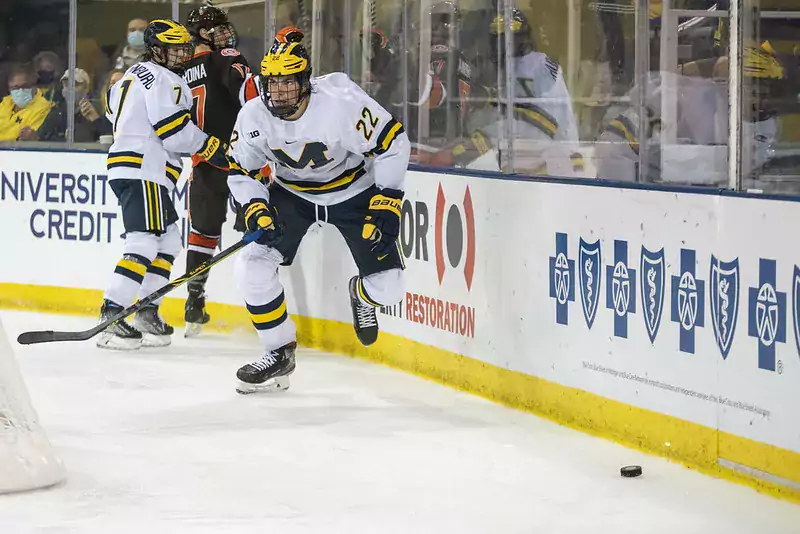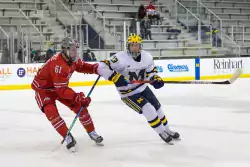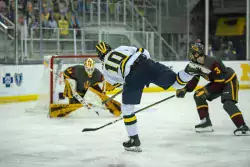2021-22 hockey preview

1 hour and 3 minutes
The Sponsors
Thank you to Underground Printing for making this all possible. UGP makes custom apparel such as t-shirts and sweatshirts and was founded by 2 Michigan alums over 20 years ago. They have 3 retail locations in Ann Arbor and offer thousands of University of Michigan athletic products for sale, ranging from clothing to accessories and memorabilia. Check them out at ugpmichiganapparel.com.
And let’s not forget our associate sponsors: Peak Wealth Management, HomeSure Lending, Ann Arbor Elder Law, Michigan Law Grad, Human Element, The Phil Klein Insurance Group, Prentice4M, and made possible by SignalWire.
The Video:
[After THE JUMP: the player and what we said]

Previously: Part 1 (Centers and Maybe Centers), Part 2 (Wingers), Part 3 (Defense & Goalies), Season Preview HockeyCast
Over the past week and a half I've been slowly rolling out my Michigan Hockey Season preview. Over the first three installments we were breaking down the roster, and today we come to the final piece of the puzzle. In this article we will instead be focusing on the rest of the conference, as well as Michigan's schedule more broadly. Then, at the end, we will make a few predictions, and wrap up the preview. Let's start by analyzing the B1G, which I have broken down into tiers:
Tier I: The Contenders - Minnesota and Michigan
Michigan
The rest of the preview articles have covered Michigan extensively, so no need to go in depth here.
Minnesota
Last season: 2nd in B1G, 24-7 (16-6), lost in NCAA Regional Final
Additions: Chaz Lucius, Matthew Knies, Rhett Pitlick, Aaron Huglen, Tristan Broz
Subtractions: Sampo Ranta, Scott Reedy, Brandon McManus, Colin Munson, Cal Burke
Minnesota was a terrific team last season, finishing 16-6 in the conference and 24-7 overall, losing out on the B1G regular season crown but they snagged the BTT title before being awarded a #1 seed in the NCAA Tournament. They flicked Nebraska-Omaha aside but then were blanked by in-state rival Minnesota State to come up a game short of the Frozen Four. Most of that team’s core returns, and they add some real talent to the mix.
The Gophers had a great defensive corps and goaltender last season and everybody in that group returns. Old Friend/New Enemy Jack LaFontaine returned to school and he was marvelous last season, posting a .934 SV% and winning B1G Goaltender of the Year honors. The defense in front of him is talented and veteran, with all six starters returning and that includes NHL first rounder Ryan Johnson (BUF) and second rounders Jackson LaCombe (ANA) and Brock Faber (LAK). Throw in a pair of late rounders in Mike Koster (TOR) and Ben Brinkman (DAL), and you’ve got a defense with six returning starters and five NHL draft picks. They’re seasoned, athletic, and can play in both ends of the ice.
The forward corps lost some real pieces, bidding adieu to their #1, #5, and #6 scorers from last season in Sampo Raanta, Scott Reedy, and Brandon McManus, which will definitely hurt, but the recruiting is good enough that there’s reason to believe they can fill the holes adequately. The Gophers bring in the most talented non-Wolverine to play in the B1G this season, Chaz Lucius, a goalscoring centerman who slipped out of the lottery but was still a solid first rounder of Winnipeg. They also bring in Toronto’s second rounder, Matthew Knies, a scrappy around-the-net winger, and Pittsburgh’s second rounder, Tristan Broz, a creative playmaking forward. Oh, and two additional late rounders, Rhett Pitlick and Aaron Huglen, join the program. The talent is flowing into Minneapolis.
That crop of good freshman join what remains from last season’s top six, notably Sammy Walker, Blake McLaughlin, and Ben Meyers. There was a considerable drop off from the top six to the bottom six last year, so Minnesota will need some of those young guys to step up and plug those holes or else there may be offensive problems. That’s probably the biggest question with this team.
The Upshot: Minnesota is Michigan’s lone competitor for the B1G crown. I think Michigan is a better team than Minnesota, but the presence of Minnesota means Michigan can’t afford to mess around like they did last year. This Minnesota team has such a high floor by returning its defense + JLF. They’re going to rack up wins on a consistent basis. I have some questions about the offense, particularly in replacing an electric presence like Sampo Raanta was, but this is a team with the talent, experience, and coaching to hang with the Wolverines, and win consistently enough to make the regular season chase interesting. Bob Motzko is a great coach and Minnesota should have a great team. Not talented on Michigan’s level, but should Michigan slip up, Minnesota will be right there to zip past them. A top two seed in the NCAA Tournament is likely for the Gophers.
[AFTER THE JUMP: The teams in the conference get worse]

Previously: Part 1 (Centers and Maybe Centers), Part 2 (Wingers)
Part 3 of our Michigan Hockey season preview gets rolling today, and it's the last component looking at the roster. The team played an exhibition game on Saturday, defeating Bowling Green 7-1, and so I included some of the scouting we learned from that game in this post. Today we'll cover defenseman and goalies, starting with the towering #1 defenseman who also was picked in a spot corresponding to that number in the NFL Draft:
Owen Power
Year: Sophomore
Height/Weight: 6’5”, 214 lbs.
NHL Draft Position: #1 overall in 2021, Buffalo
Stats: 3-13-16 in 26 games, 7.3% shooting, +20
When Owen Power takes the ice for Michigan in the season opener he will make history, becoming only the 2nd first overall pick in history to play NCAA hockey after being drafted. Power went first overall to the Sabres (condolences, Owen) and it was largely because he was seen by scouts a lot like how Beniers was, as a trusty, safe option in a draft filled with uncertainty. The potential of such prospects as Luke Hughes and Simon Edvinsson may be greater than Power, but none of them have close to the floor that the towering defenseman from Mississauga does. As it stands, he could probably be a third pair guy in the NHL right now. But instead, he came back to Michigan to try and improve, and that was the right idea, because there is room for him to grow.
Power’s freshman season at Michigan saw him paired with Nick Blankenburg for the entirety of the year, and they were a very good tandem. Power made an impact right from the beginning of the season, finishing off this beautiful passing sequence against Arizona State (starts at 0:42):
Lots of career firsts in our 8-1 win over ASU - check out Beniers, Bordeleau and Power netting their first ?and Johnson and Brisson grabbing their first ?#GoBlue〽️ pic.twitter.com/AmOWm48seY
— Michigan Hockey (@umichhockey) November 15, 2020
As the year went along, Power began to flash the traits that made scouts envy him so much. He’s a terrific skater for a 6’5” defenseman, and the long reach is his biggest weapon as a defender, allowing him to nullify plays that other, smaller defensemen can’t. His frame also makes him a shot-blocking weapon to be used on the PK, and his brain is quite solid, normally electing the smart, simple play to get the puck out of the zone and up ice. Though no one will mistake him for Quinn Hughes or Cale Makar as a transition machine, Power is comfortable skating up the ice with the puck but will also chip the puck if it’s the better play. He’s a heady defender who normally makes the right read, whether that’s breaking a play up or executing a crisp pass. Also, the skill, though he didn’t flash it as often as a Hughes brother might, is there:
Owen Power from Kent Johnson and Thomas Bordeleau and we are knotted at 1-1 pic.twitter.com/0wOpFbnxBY
— Michigan Hockey (@umichhockey) February 14, 2021
When he wants to skate around with the puck, he can do it comfortably:
The wheels by Power + the screen by Bordeleau + the shot by Blankenburg = Michigan Goal pic.twitter.com/YUjUSR5TzX
— Michigan Hockey (@umichhockey) March 6, 2021
And for the record, his shot has a good bit of zip on it, as you’d expect for a player that size:
Owen Power with a rocket from Blankenburg and Beniers and it's 2-0 Michigan! pic.twitter.com/HfNydSzoez
— Michigan Hockey (@umichhockey) January 17, 2021
There’s not much he can’t do, but the challenge for Power this season will be growing in two areas: flashing that skill more regularly to add a dynamic touch to his game, and becoming a meaner, more physical defender. For the first point, I just showed you some nice highlights of Power skating and pulling some moves, but those were few and far between. As I noted a couple paragraphs ago, Power’s game last season was built around simplicity and routine, not razzle dazzle. The skating ability and the hands are there, but can he come out of his shell a little more and make things happen? That may be the difference between him becoming a Noah Hanifin-type or a Rasmus Dahlin-type at the NHL level.
Secondly, I’d like to see Power use his frame a little bit better. For a player that size, he was far too unwilling to impose his will on the opponents. If Power doesn’t become a dynamic offensive defenseman, then he needs to make up for it in his own end and there are pretty clear roadmaps on how to do that. Chris Pronger and Rob Blake were not dynamic offensive defensemen, but they made up for the lack of flashy highlights by being an absolute menace in their own end, adept at using their massive size to clear the netfront and vicious in applying the ole crosscheck to the midsection to win puck battles in the corner.
Power won’t be able to get away with some of the stuff Blake and Pronger did in NCAA hockey in the year 2021-22, but I’d like to see him realize that he’s a lot bigger than every other player on the ice and use that size to his advantage defensively. There should be no one near the crease when Power is on the ice, and he should aim to become harder to play against physically when a puck battle ensues. Michigan is going to be oozing skill this season, but Power is one of the key players who should bring the muscle.
If he can improve in these two areas, adding a little bit more of a dynamic component to his game and becoming more physically aggressive in playing defense, the sky’s the limit for Power this season.
Season Expectations: There will be a healthy crop of competition coming from Minneapolis (and from Blankenburg), but Power should win B1G Defenseman of the Year this season. He’s got more talent than anyone in the conference, and assuming he and Blankenburg get even larger PP roles with York gone (we saw Power on PP1 in the exhibition game), I’d like to see Power approach a point-per-game this season, while playing strong defense in his own end. Power and Blankenburg should be Michigan’s Nicklas Lidstrom-Brian Rafalski tandem, an all-situations, minutes-chomping pair that plays 28 to 32 minutes in high-leverage games (read: the NCAA Tournament). PP, PK, even strength, you name it, Michigan should lean on Power heavily. Maximize the last season you get with the unicorn before he leaves for Buffalo.
[AFTER THE JUMP: Mr. Captain and more]

Some more forwards, and some more Hobey candidates.

6